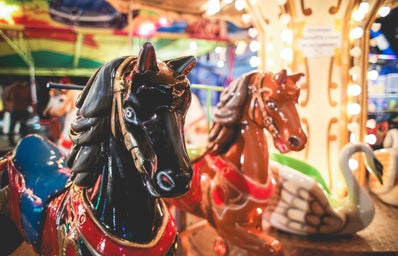Leonora Carrington is one of my favorite artists from the surrealist movement, not only because she is one of the few women that brought the surrealist movement into the eye of the masses through her paintings but also because she touches a lot of themes through her art that is still relevant to the modern woman.
She was born in Britain and later immigrated to Mexico to establish herself as an artist. While she has a variety of pieces that depict the story of her life, today I’m going to tell you about “Inn of the Dawn Horse.” This was the piece that launched her to fame.
“Inn of the Dawn Horse” is a self-portrait that features two of the most important elements of her art; a white horse, and a hyena. Carrington noted that she always felt identified with both animals, and mentioned that they both represented different perspectives of her psyche. The white horse represents a more controlled, domesticated, and pure side of her womanhood. The hyena represents the “intrusion of the wild into a domestic space”; in other words, a more sinister, wild, and uncontrolled version of herself, ready to be discovered.
The placement of both animals in this painting is one of the key characteristics to break down the meaning of this piece. We can see the white rocking horse of her childhood hung upon the wall, no longer useful, almost shadowed by one of the main characters of this piece; herself. The white horse on the wall is also mirrored by the smaller horse seen through the window, running wild in what seems like a forest, finally let free. These white horses, one hung up on the wall, the other running wild (quite literally, out the window), represents the innocence and purity of a child leaving her character, and, while they are still present in the picture, they are no longer relevant in her life.
These white horses are metaphorically overshadowed by the other central character in this piece, the hyena. The hyena is portrayed with enlarged teats (a symbol of her new discovered sexual drive), stretching her paw out to Carrington’s figure, who is also stretching her arm back, in a symbolic picture of acceptance and reunion with this new side of herself. It is also very interesting to see how the stares of the hyena and Carrington are mirrored towards the viewer, almost obligating you to look at them both in the eyes, giving them a characteristic in common, since they have now become the same figure. The hyena in this painting represents this new discovered self, a more obscure, feral version of the horse, with more hunger for curiosity, slowly creeping up on her as a hyena would.
I believe this piece to be a beautiful depiction of a girl transitioning to a deeper, more complete understanding of womanhood, where, while there are still reminiscing aspects of purity and childhood, these aspects are no longer in use, turning Carrington into a darker, wiser woman. In more modern terms, this piece portrays a woman discovering her femme-fatale.


